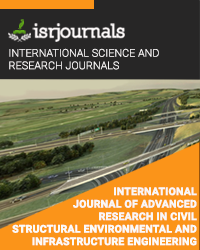experimental analysis of impact on quality quantity of water bodies in chennai
A.S.Kanagalakshmi ,N.Mohammed Saleem Badhusha,P.Gokul Sudharsan,R.Ranjith,S.Sanjay Krishnan
Published in International Journal of Advanced Research in Civil,Structural,Environmental and Infrastructure Engineering and Developing
ISSN: 2320-723X Impact Factor:1.7 Volume:3 Issue:1 Year: 05 April,2017 Pages:465-475

Abstract
Rapid urbanization throughout the world leads to pressure on infrastructure development for planners. The provision of clean water, treatment and disposal of wastewater has become a challenge to water resources and environmental engineers. It is perceived that new approaches will reduce the water stress and can contribute markedly to improve the availability of water. This research work relates to water management aspects of Chennai Metropolitan Area (CMA), Tamil Nadu state in its entirety to suggest effective measures for improvement. Chennai Metropolitan Area spread over 1172 sq. km. with a population of about 6.6 million consists of Chennai city, 13 municipalities, 23 town panchayats and 214 village panchayats of which 18 were classified as census towns. Chennai citys water supply is governed by the Chennai Metropolitan Water Supply and Sewarage Board and Tamil Nadu Water Supply and Drainage Board looks after the water supply aspects in Municipalities, Town Panchayats and Village Panchayats of Chennai Metropolitan Area. A detailed literature review regarding water demand and supply, wastewater management and stormwater management are carried out. Water scarcity, water quality determination, inadequate institutional capacity, lack of comprehensive regulation and financial constraints are some of the aspects that need to be looked into to develop plan for further investigation. Essentially this study indicates the opportunity for creating additional storages, making use of the available tank storages, additional water treatment plants with its location, to utilize the, Veeranam water , Poondi, chembarampakkam, cholavaram waters within Chennai Metropolitan Area suitably. Various technical investigations essential for planning water resources development activities for Chennai Metropolitan Area are indicated. This will serve as the starting point for the long term development of water management policies for this area.
Kewords
Tamilnadu Water supply And Drainage Board (TWAD BOARD), Mean Sea Level (MSL), Capacity, Catchment area, Chennai Metropolitan Area (CMA), Hard-rock run
Reference
#1.Chennai government of Tamil Nadu http://www.cmdachennai.gov.in #2.Chennai Metropolitan Water Supply and Sewerage Board (CMWSSB) in Tamilnadu http://www.chennaimetrowater.gov.in #3.Population of Chennai city http://www.census.co.in #4. CWC/MWR (Central Water Commission, Ministry of Water Resources). 2005. Rainfall in different meteorological zones of India #5. Environmental Planning Frame Work for Water Resources Management in Tamil Nadu, Public Works Department. Government of TamilNadu. #6. Ground Water Resources of Tamil Nadu,2002,Public Works Department. Government of TamilNadu. #7. Jain SK, Agarwal PK and Singh VP 2007. Hydrology and water resources of India (Dordrecht, Netherlands: Springer) #8. National Water Policy, 2002. Government of India, Ministry of WaterResources. New Delhi, April, 2002. #9. Central Water Commission [CWC] (2010), Preliminary Consolidated Report on Eff ect of Climate Change on Water Resources, Government of India, available at: http://cwc.gov.in/main/downloads/Preliminary_ Report_fi nal.pdf #10.“Historical Background” Chennai Metro Water. #11. Srinivasan, M. S. (15 September 2003). "Desalination: Answer to Chennais water woes". Business Line. Chennai: The Hindu. #12. Lakshmi, K. "Metrowater to fathom needs of merged areas". The Hindu. Chennai: The Hindu.

